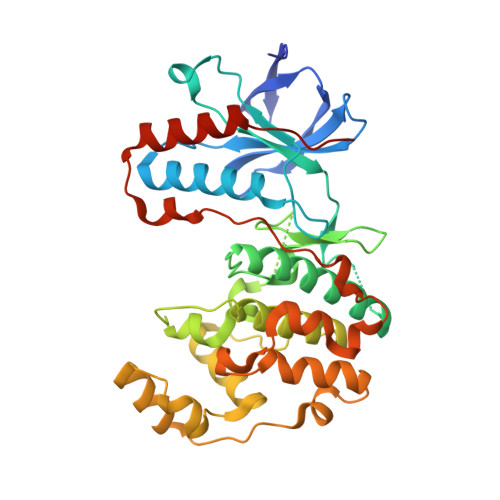2-Azo-, 2-diazocine-thiazols and 2-azo-imidazoles as photoswitchable kinase inhibitors: limitations and pitfalls of the photoswitchable inhibitor approach.
Schehr, M., Ianes, C., Weisner, J., Heintze, L., Muller, M.P., Pichlo, C., Charl, J., Brunstein, E., Ewert, J., Lehr, M., Baumann, U., Rauh, D., Knippschild, U., Peifer, C., Herges, R.(2019) Photochem Photobiol Sci 18: 1398-1407
- PubMed: 30924488
- DOI: https://doi.org/10.1039/c9pp00010k
- Primary Citation of Related Structures:
6HMP, 6HMR, 6HWT, 6HWU, 6HWV - PubMed Abstract:
In photopharmacology, photoswitchable compounds including azobenzene or other diarylazo moieties exhibit bioactivity against a target protein typically in the slender E-configuration, whereas the rather bulky Z-configuration usually is pharmacologically less potent. Herein we report the design, synthesis and photochemical/inhibitory characterization of new photoswitchable kinase inhibitors targeting p38α MAPK and CK1δ. A well characterized inhibitor scaffold was used to attach arylazo- and diazocine moieties. When the isolated isomers, or the photostationary state (PSS) of isomers, were tested in commonly used in vitro kinase assays, however, only small differences in activity were observed. X-ray analyses of ligand-bound p38α MAPK and CK1δ complexes revealed dynamic conformational adaptations of the protein with respect to both isomers. More importantly, irreversible reduction of the azo group to the corresponding hydrazine was observed. Independent experiments revealed that reducing agents such as DTT (dithiothreitol) and GSH (glutathione) that are typically used for protein stabilization in biological assays were responsible. Two further sources of error are the concentration dependence of the E-Z-switching efficiency and artefacts due to incomplete exclusion of light during testing. Our findings may also apply to a number of previously investigated azobenzene-based photoswitchable inhibitors.
Organizational Affiliation:
Otto Diels-Institute of Organic Chemistry, Christian Albrechts University Kiel, Otto-Hahn-Platz 4, 24118 Kiel, Germany. rherges@oc.uni-kiel.de.
















